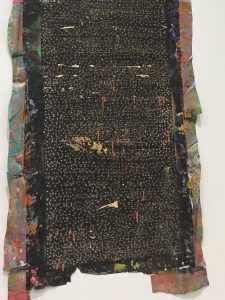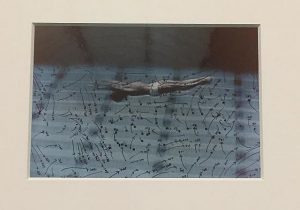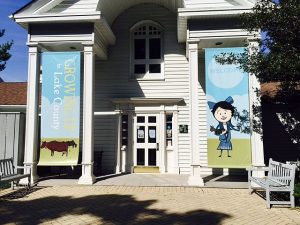“I look at my work sometimes as play… a kind of joyous play.”
So said artist Howardena Pindell at the Museum of Contemporary Art opening of “What Remains To Be Seen.”

Even though Pindell’s works have been in shows every year for the past several years, the current MCA exhibit is the first, all encompassing survey of her 50-year career.
It includes her move from figurative to abstraction and activism to occasional returns to figurative forms. But throughout the periods are personal reactions to what it feels like to be black and female. Yet, the playfulness is evident throughout the exhibit.
Pindell enjoyed finding different tools and materials to create art including hole punchers, file-folder stock and beveled cutouts found in a museum’s trash where she was an assistant curator.
The exhibit features several works where holes were either punched or painted by means of oak-board stencils. Some are best viewed up close to note that works that at first appears monochromatic, isn’t.
The show reveals a fascination with numbers, math, patterns and grids. Indeed, visitors who look closely will find numbers in some of the hole-punch designs.

But in some works, the holes are merely a fascinating pattern.
In another series, numbers and arrows add interest to Pindell’s video drawings as if they were instructions. Created on acetate held by static electricity to a television screen, they are an impressive, unusual form of art.

“I was looking for a fun way to use the videos,” she said. She pointed out that some people thought the numbers and arrows looked like football playbook arrows.
Another technique was cutting up postcards from her extensive travels to form collages.
Part of her “Autobiography” series, they were memory aids because a life-threatening accident in 1979 included a serious concussion that resulted in temporary memory loss.
Work that is play in Pinell’s career is based on a strong art background.
Born in 1943, Pindell graduated from the Philadelphia High School for Girls and studied art at the Philadelphia College of Art and other art schools before getting a BFA from Boston University and MFA from Yale.
“They all wanted me to use figurative art when I was moving into abstraction,” Pindell said at the exhibit opening.
She felt some satisfaction when an influential woman in the academic art world who had expressed a negative view of Pindell’s favoring abstraction over traditional figurative style, turned up at the Museum of Modern Art (NYC’s MoMA) where Pindell was working (first as an exhibit assistant and then an associate curator). “When she saw me, she said, “Oh.”
The MCA exhibit features her different styles. But what also comes across is her use of pattern and color.

Collection of Nancy and Peter Huber.
Pindell, a longtime professor of art at Stony Brook University, New York (part of SUNY, a state university), stressed the importance of understanding color depth. She pointed out that she focused on the composition of color with her painting students.”They learn it’s not just, “red,” she explained.
No matter what the subject or materials used, exhibit visitors will see how Pindell’s use of color is very effective, ranging from ethereal to a rich.
Colors, materials and pattern movements seem to draw visitors into her works. Pindell refers to that phenomenon as “space.” “What I’m working on now is space going into the painting and space going out of the painting.”
She also puts herself into her works, literally.
Tips: Don’t walk too fast past “Autobiography: Fire (Suttee),” 1986-87. Done in mixed media on canvas and on loan from the Nancy and Peter Huber Collection, its rich colors and patterns might obscure the fact that there is an outline of Pindell’s body in the picture
It references a former custom of expecting a widow in India to kill herself after her husband dies. It also stands for human suffering and her own experiences with being black and a woman.
Also watch her in the performance video, “Free, White and 21” (1980) when she compares black and white women’s experiences.
DETAILS: “Howardena Pindell: What Remains To Be Seen,” is at the Museum of Contemporary Art Chicago, 220 E. Chicago Ave., now through May 20, 2018. For more information call (312) 280-2660 and visit MCA Chicago.
Jodie Jacobs



